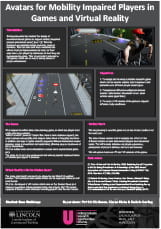by Samuel Stubbings //
 Existing research has studied the design of movement-based games to support mobility impaired players. This has focused on design elements, such as controls and interface. Thus far, little work has considered the effects of player representation, nor player’s preferences on how they are represented in games. This is particularly relevant to virtual reality (VR) games, which can convey a strong sense of player embodiment.
Existing research has studied the design of movement-based games to support mobility impaired players. This has focused on design elements, such as controls and interface. Thus far, little work has considered the effects of player representation, nor player’s preferences on how they are represented in games. This is particularly relevant to virtual reality (VR) games, which can convey a strong sense of player embodiment.
To create a game fit for such an audience, the complexity of the game’s mechanics must be considered. As a result, an ‘infinite runner’ genre was chosen. This is as the gameplay is reaction based with minimalistic input, so that a wider audience can enjoy the game with little to no gaming experience.
The game was created in the Unity engine, this was because the support for the Oculus Quest is plentiful and because I have experience working with this engine. A basic prototype of the online version of game was created in the first few days. Then a further week and a half was spent adding content and polishing. This was so that the game could be perceived being of quality, as well as the improved user experience that comes with a ‘juicier’ game.
To further improve the gameplay, a high score system was implemented as well as coins to collect to unlock cosmetics for your character. This was to give players a reason to play the game more than once, as there is a larger goal to work towards. This also brings more attention to the avatar, as the player can express themselves through cosmetic choices.
The virtual reality versions of the game were created in the final week. During this time, I learnt how to use the Oculus SDK and deploy builds to the Oculus Quest. This was tricky at first as a couple new programs needed to be installed and learnt. This will help me in the future, especially with the VR module of my course next year as I’ll already have some experience with the hardware.
When porting the game to the Oculus Quest, the game’s interface had to change accordingly. The main part that changed was the control system as using a keyboard in VR is impracticable. As a result, control schemes using both real world locomotion and the Oculus Touch controllers were added. This allows the player to decide what they are most comfortable with, depending on their mobility impairment. Also, any forced rotations were removed to reduce the risk of motion sickness.
*To view Samuel’s project poster, please click on the thumbnail below:
